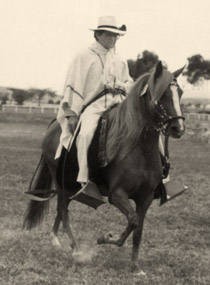|
|
by Alfonso Alejandro Figuerola Saavedra Published in the April 2004 edition of Made In Peru Magazine as a preview of Mr. Figuerola's upcoming book, Equus Peruano.  The author riding at the Peruvian Nationals in Mamacona, Lima, Peru. Thanks to his close friendship with my grandfather don Antonio Alfonso Figuerola Arana, my uncle don Federico de La Torre Ugarte used our Chepenano gray stallion, AFA Lurifico. AFA Lurifico was by El Galponero, from Augusto B. Legía, and out of an Esteves mare from Hacienda Lurifico. Federico used AFA Lurifico to produce the gray stallion, FTU Altanero, out of FTU La Zapata II. Federico also had access to our other studs, including AFA “Tarzán” de Figuerola (AFA Lurifico x La Gonzalez de Figuerola), a black stallion; and “El Moro” de Figuerola (El Ucupano x Compodónico mare from Hacienda Rafán), a gray stallion. Federico used these stallions to cross with “his” foundation mares. And thus the famous FTU brand was born, thanks to the offspring produced by a select herd of only four fine mares, of which three were owned and bred by Federico’s relatives, the renowned Jequetepecanos hacendados don Antonio Saavedra Alvarez (my maternal great-grandfather) and don Alejandro Saavedra Sisniegas (my maternal grandfather), who lent them to him. The fourth mare was from my uncles don Roberto and don Augusto Luna Polo-Esteves, who previously acquired it from my uncle don Salvador Zapata Salcedo from Chepén. Federico would soon become known as a provider of fine beasts to almost all of the contemporary new breeders (he himself being one) during the reappearance of the breed, at the beginning of 1937. The popularity of the Peruvian horse would greatly intensify after the establishment of the ANCPCPP in 1947; this was followed by the first official Championships of the Breed, the horses of which were used to establish the previously non-existent Breed Standard and to define its pisos or its paces. Those were the days when no more than twenty centenarian families of breeders existed in Peru. The Figuerola stud, holder of the AFA brand, established by Don Antonio Alfonso Figuerola Arana in Chepén and Pacanguilla, had an interesting chronological history during its own half-century of existence (1909-1968). The first were the Chachapoyano riding horses of Celendín, centennially raised by his grandparents De Arana and Del Risco, who used them for traveling to and from the coast (Pacasmayo), over the endless and desolate Cajamarquino trails, crossing the Andean mountain range that sheltered its rustic Parameros equines. During the long journey they demonstrated their great stamina, smooth and firm footfalls, and even cadence, characteristic of their fine paces. The origin of these brown, bay, black and gray horses was vaguely lost in history, due to the fact that they were travelling “pacers”, characteristic of colonial Nobles and Viceroys, between the two most important centers of horse breeding established during the Spanish conquest of Peru. One was in the coastal valley of the Zaña River, via Jequetepeque; the other was in northern Trujillo del Peru in eastern Luya, the land of the Chachapoya natives. The original Saavedra stud was established at Hacienda Chafan Chico by don Antonio Saavedra, my maternal great-grandfather. While at don Alejandro Saavedra’s (my maternal grandfather) Hacienda La Calera, he described to me the origin of his stud. “I am only the recipient and continuant of the same ‘Cordobesa’ stud, belonging to our many Haciendas, established in our Jequetepeque valley from 1740. These same horses were originally bred in isolation by their former landowners, the Augustinian Friars, for over a century. After the Spanish Conquest, the horses were donated, and the Saavedra stock was supplemented by our predecessors, refining it with their fine beasts, brought from Piura, Lambayeque, and Zaña, as well as from the city of the kings, Lima.” |
